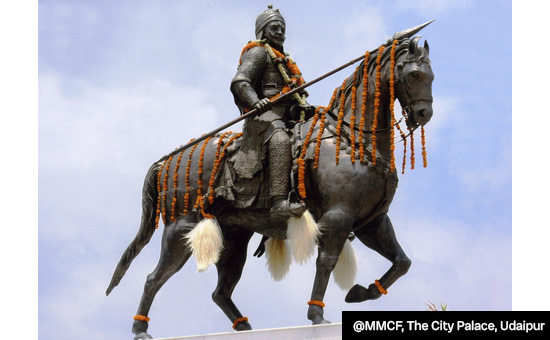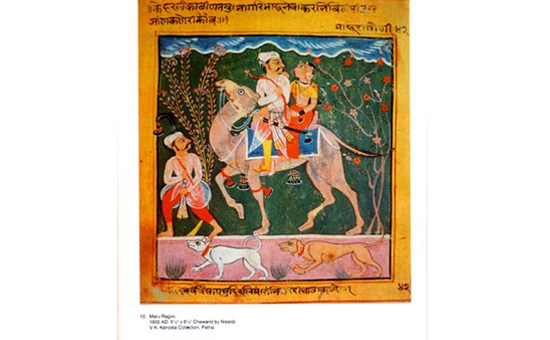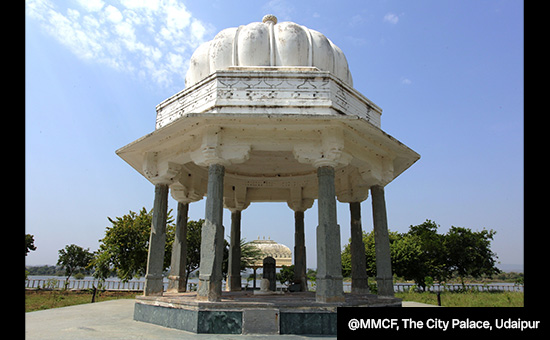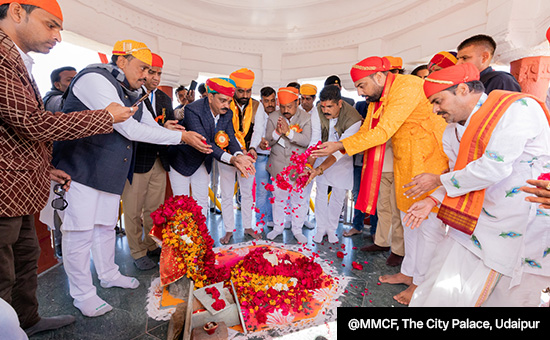- On the 484th birth anniversary of Veer Shiromani
Maharana Pratap on Vikram Samvat 2081 - Jyeshtha Shukla Tritiya on Sunday, June
9 2024 we tell about the history, arts, culture, significance and water
filtration system of Chawand, his capital.
After winning the battle of Dewair in 1582 CE, Maharana Pratap I (r. 1572 - 1597 CE), 54th Custodian of the House of Mewar, following the policy of his father Maharana Udai Singh II propounded the idea of building a new and safer capital in mountainous region. So, he established his capital city at Chawand in 1585 CE.
Maharana Pratap gained
control of the Chappan area including Chawand and this place had a very
important role in the history of Mewar region.
The landscape around
Chawand made it an ideal location to set up a fortified capital. It is about 60
kms southeast of Udaipur and surrounded by the Aravalli hills on all sides,
creating a secure environment (Shyamal Das 1986: 158). The town itself is
situated thirteen kms east of a village called Parsad i.e. on the left bank of
the Gargal River.
Maharana Pratap built his fort at the center of the hill. From this fort, one could see far into the distance, helping to keep watch. The remains of Maharana Pratap's fort still exist today, including parts of the strong fortification wall that encircled the hillock it was built on. Inside the fort area, there are ruins of the palace like structures where the Maharana and his nobles likely lived.

Chawand is an
archaeological treasure trove that provides a
window into the life, times and legendary resistance of Maharana Pratap against
the Mughal forces. Chawand played a vital role in the development of Mewar,
after the Mughal struggle.
Why was the location of Chawand important?
It was situated on the
main trade route of Gujarat. Soon, it became a centre of merchant activities.
Apart from this, Chawand was a safer place; it was also possible to take
control over Zawar or its nearby mining area that is why Maharana Pratap chose
Chawand as his capital.
Fort
Archaeological
excavations by the Archaeological Survey of India have uncovered the remains of
several rooms that were likely residential quarters. Most of these rooms are
rectangular or square in shape. Some rooms have partially open walls still
standing. In total, five different room remains have been identified, with sizes
ranging from about 2.3 meters x 3.2 meters up to 5.2 meters x 3.2 meters. The
door widths vary from 1 meter to 2.65 meters wide. The ceiling heights that
remain are around 2.5 meters high, and the walls are about 0.6 meters thick
(Kharakwal 2019:135).
The ruins provided a glimpse into how the royal family and their nobles may have lived - likely in modest yet functional quarters within the secure confines of the fortified hillock. Just outside the south-eastern corner of the fort's fortification wall, there are remains of what may have been a two-story building complex. These included rectangular and square shaped rooms. Some of the room walls still have thick plaster coatings made from a mixture of lime and brick powder. Pieces of glazed ceramic pottery wares in colors like green, turquoise and shiny glazes were also found here (Kharakwal 2019:135).
In the area
surrounding the fort, there are scattered remains of modest house dwellings.
These likely belonged to the common people living around the royal palace. The
remains show small rooms, open courtyards, and signs that the roofs were
thatched using bamboo and grass, as evidenced by grass pieces found in the
brick walls.

Ancient Water Filtration System
One remarkable
discovery at Chawand is the remains of an ancient water purification system
located in the south-eastern corner of the fort. Here, archaeologists found a
rectangular structure with 26 interconnected pits of various rectangular and
square shapes. These pits were lined at the bottom with holes connecting them
all.
It appears that water
was made to flow through this series of pits, likely using sand and coal layers
to filter and purify it before collecting in a larger final pit. This
pioneering water treatment system shows the advanced civil engineering and
filtration skills that existed then. It highlights how the builders planned and
implemented civic utilities like clean drinking water supply.
How was Water Supply managed?
Chawand had other water sources that made it an ideal location. To the west was a lake called Kataval. Maharana Pratap himself had commissioned the construction of an impressive step-well near the fort. This well had three sets of stairs leading down to the water body. Additionally, the Gargal River’s seasonal streams flowed through this region from the west towards the south-east direction. This allowed the land around Chawand to be fertile for cultivation of crops like rice, wheat, maize, and fruits like mangoes.
This agricultural
abundance is considered one of the main reasons why strategically, Maharana
chose to make Chawand his capital after being displaced from capital centers
like Chittorgarh and Kumbalgarh by Mughal forces.

Shree Chamunda Mata Temple
Inside the fort, in
the north-west side, there is a temple of Shree Chamunda Mata (Shyamal Das
1986: 158). This temple is built on a high platform in the Rekhadeval
architecture style. The temple faces north and includes a Garbhagrah, Mandap
(Pavilion) and Pravesh Dwar (Entrance Gate).

Maharana Pratap Memorial
Maharana Pratap
memorial has been developed by The Department of Tourism, Government of
Rajasthan, in the south direction of the fort at Chawand. A statue of Maharana
Pratap was installed along with his associates Rana Punja, Hakim Khan Sur,
Jhala Maan and Bhamashah.

Center of Arts and Culture
Chawand was a seat of
learning and scholars were patronized by Maharana Pratap. Later on, Maharana
Amar Singh I also continued the legacy of his father and Chawand was developed
into an educational and cultural center of Mewar during his reign carrying on
till the 18th century.
Under the patronage of
Maharana Pratap Sinhasan Battisi, Jyotishsar, Shrimad Bhagwat Dashamskandha etc
Sanskrit literature was composed by various scholars at Chawand (Bhatnagar
1989: 90). A new style of painting developed in Mewar, called Chawand
Painting Style. Nisaradi was the artist who illustrated the famous Ragamala
miniature painting series in 1605 CE (Paliwal 1998: 66-67).

Maharana Pratap Samadhi
From 1572 CE to 1597 CE, Maharana
Pratap ruled for 25 years of which he spent twelve years in Chawand. His cremation was performed on the banks of the Gargal
River at Badoli village near Chawand. An eight ornate stone pillars cenotaph
was constructed at the cremation site by Maharana Amar Singh I, which remains a
sacred place of homage for people, in and around that area, till date. In 1937
Maharana Bhupal Singh renovated the cenotaph.

Maharaj Kumar Sahib
Dr. Lakshyaraj Singh Mewar visited Chawand and paid tribute to Veer Shiromani Maharana
Pratap with reverence and faith at Nirvana Sthali Chawand on his 426th death
anniversary on 1st February 2023. Dr. Mewar addressed the gathering and said
that Maharana Pratap is synonymous with bravery, sacrifice, and self- respect.
He called upon the future and young generation of the country to follow the
ideal life values of Maharana Pratap with the faith with which they believe in
Maharana Pratap and spread the pious thought of patriotism to the masses.
 Dr. Lakshyaraj Singh Mewar paying tribute to Veer Shiromani Maharana Pratap at Nirvana Sthali Chawand.
Dr. Lakshyaraj Singh Mewar paying tribute to Veer Shiromani Maharana Pratap at Nirvana Sthali Chawand.
Though the fort and
structures are now in ruins, they stand as a testament to spirit of sovereignty
of Maharana Pratap who despite being massively outmatched found ideal
conditions in the hills, forests and natural defenses around Chawand and
fought, against the Mughals for over two decades, in the guerilla warfare way.
The Archaeological Survey of India's ongoing excavation and restoration efforts are finally bringing Chawand's historic significance into the light.
So while modern India rediscovers its medieval heritage, the forgotten heroic legacy of Maharana Pratap's resistance will be resurrected from history to inspire new generations. The romantic ruins of his capital at Chawand will forever remain hallowed grounds - silent sentinels that saw this legendary leader's quest for freedom from Mughal occupation reach its ultimate culmination.
 It all
started at Kumbhalgarh Fort where Maharana Pratap was born.
It all
started at Kumbhalgarh Fort where Maharana Pratap was born.
References
1. Maharana Mewar
Research Institute, Maharana of Mewar Charitable Foundation, The City Palace,
Udaipur.
2. Devilal Paliwal,
1998| Maharana Pratap Mahan, Rajasthani Granthagar: Jodhpur.
3. J.S. Kharakwal,
2019| Archaeological Exploration of Chawand. Shodh Patrika 70: Udaipur.
4. Rajendra Bhatnagar
1989| Maharana ki Nayi Rajadhani Chawand or Uska Sanskritik Mahtva, Maharana
Pratap and His Times, Maharana Pratap Smarak Samiti: Udaipur.
5. Shyamal Das, 1986|
Veer Vinod, Motilal Banarasidas: Delhi.
Authored by Ms. Swati
Jain, Research Officer, Maharana Mewar Research Institute, Maharana of Mewar
Charitable Foundation, The City Palace, Udaipur 313 001, Rajasthan.